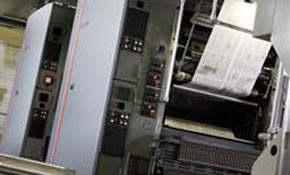
When was it launched and what market is aimed at?
This 75,000-copies-per-hour (cph) version of the Goss Universal 2×1 cylinder format web press was unveiled at Ifra Expo last October. According to Peter Kirwan, Goss International’s vice-president of Asia-Pacific newspaper sales, the Universal was launched in response to a greater need for higher production speeds within the mid-volume newspaper market. Most of these printers fill capacity by contract printing for external publishers – put simply, the faster they can print, the more contracts they can accept. Contract printing has become more lucrative as run lengths reduce and as modern presses allow printers to diversify into more products.
How does the press work?
A web of paper is fed from a reelstand through a unit or a tower of units, printing both sides of the web. Units can be single for mono colour or stacked on top of each other vertically to form a tower. Each unit in the tower prints a single colour on both sides of the web at high speed. The printed web is fed into a folder, which cuts and folds the pages into editions.
What’s its USP?
According to Kirwan, the new Universal meets the dual requirements of single-width agility and high output. He says it has been enhanced with the same blanket lock-up features used in other high-end Goss commercial web presses, enabling it to maintain the same quality at a faster speed. While he acknowledges there are a variety of presses within the sector that could be recommended to satisfy the production demands of a particular printer, he believes the Universal gives customers more options and flexibility.
How does this press differ from other Universal models?
It’s 50% faster. The original Universal 2×1, launched in 1991, ran at 50,000cph. This latest single-width model is available in cut-offs from 530mm to 630mm and web widths from 840-1,000mm. The Universal is also available in 4×1 and 4×2 double-width, single-circumference formats (eight and 16 pages per cylinder revolution respectively), as well as a 2×2 single-wide, double-circumference model. A double circumference means print signatures can be collected together. The 4×1 format is especially suitable for newspaper printers that produce many different editions quickly but don’t need the capacity of 4×2 or 6×2 presses.
How easy is it to use?
Goss claims the shaftless design, with one motor per unit, means tension control is better so there are fewer web breaks. The design is also said to make it easier to operate and offers “top-level” automation features. These include: high-speed web-up; tower phasing; quarterfold blade phasing; and ink and register presetting from CIP4/JDF files. Up to 30 jobs can be stored and recalled, and there are separate servers for job preparation, logging, reporting and maintenance, enabling easy data retrieval for all aspects of production.
What training and level of service support can users expect?
Kirwan says Goss offers extensive training, at its own facilities and on-site. Regardless of the age of the press, Goss can provide interactive ‘flight simulator-type’ software to help train new personnel. Should anything go wrong with the press, Goss has “round-the-clock” remote diagnostic support as well as a 24-hour emergency breakdown hotline. Goss says spares can be supplied quickly and efficiently. Goss can also provide an on-site inventory service for customers to ensure they hold a full stock of essential spares at all times.
How much is it and how many are installed?
Goss launched the product in October and is ready to take orders. Kirwan was unable to give a local price as configurations vary so much. The web offset press market continues to be slow and, thus far, there have been no shipments of this latest member of the Universal family, although, across the whole range, 4,900 Universal units have been installed since 1991.
Specifications
Max speed: 75,000cph
Size (cut-offs x max web widths available):
• 530 or 533x840mm
• 546, 560, 578 or 600x914mm
• 620 or 630×1,000mm
Footprint: 16.×4.7×3.3m
Weight: 24 tons
Contact: Goss Graphic Systems (03) 9560 1666 www.gossinternational.com
The Alternatives
Manroland Rotoman
Like the Universal, the single-width variant of the Rotoman range can print up to 75,000cph. It has improved in performance over the years too. One example was the introduction of automated plate changing – it takes two minutes to change plates on all eight cylinders.
Speed 75,000cph
Size (cut-offs x max web widths available) 578, 598, 620 or 630×965 or 1,000mm
Contact Manroland Australasia (02) 945 7900 sales@manroland.com
KBA Continent
The Continent 2×1 cylinder format press is based on the technology of KBA’s better-known 2×2 Comet. The 75,000cph machine uses KBA’s shaftless drives and comes in a tower configuration to support high colour content. A heatset package with modified folder is optional.
Speed 75,000cph
Size (cut-offs x max web widths available) 546 or 630×1,000mm
Contact KBA Australasia 0419 616 427 davelewis@kbaaustralasia.com
Solna D680
Solna’s single-width equivalent to the Universal is the D680. Two folders are available, the Solna F400C, which allows a maximum speed of 75,000cph in straight mode and 37,500 in collect mode, and the Wifag Jaw KF115. The KF115 is based on a modular design and is automa-ted for a number of operations, which ensures fast changeovers.
Speed 75,000cph
Size (cut-offs x max web widths available) 546x840mm, 560 or 578x915mm
Contact Thortec (02) 8539 7644 www.thortec.com.au
Comment below to have your say on this story.
If you have a news story or tip-off, get in touch at editorial@sprinter.com.au.
Sign up to the Sprinter newsletter
